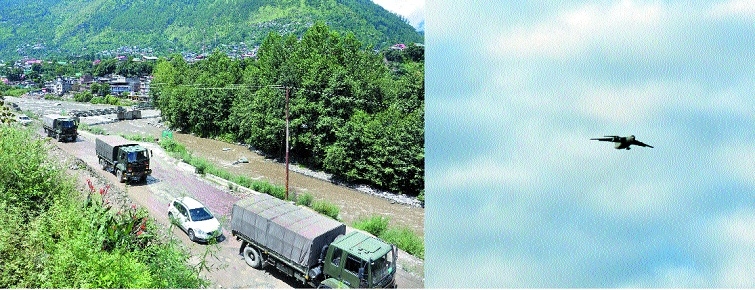India can stand solo against China in any border dispute: Think tank
| Date :09-Aug-2020 |

Army vehicles on the Manali-Leh road leaving for Leh with military contingents for troops deployed at Ladakh in Kullu on Friday. (R) Indian Air force aircraft seen flying in Leh on Friday against the backdrop of recent border dispute with China. (ANI)
AMSTERDAM ;
“Just like in Doka La in 2017, the firmness and resolve displayed by the Indian political and military leadership in the face of Chinese transgressions have surprised China,” said European think tank
AFTER the violent June 15 Galwan Valley clashes, India has shown the confidence of standing solo against China in any future border dispute despite the United States’ offer of forming a Quadrilateral Security Dialogue or Quad alliance against Beijing, a European-based think tank said. Since the clashes in Eastern Ladakh, several negotiations between India and China have taken place.
Though they have yielded some results as troops of both countries started pulling back in some of the disputed sectors, Chinese troops are still present in the Depsang Plains region, Gogra, and the Fingers region along the Pangong Tso. “In the initial phase of disengagement at Pangong Tso, the Chinese moved back from Finger 4 to Finger 5, but continued with their deployment on the ridge line. India is insisting that China move back from Finger 5 to its old position on the Finger 8 spur.
In the face of repeated demands by the Chinese negotiators that India move its troops back from the forward areas, India has refused to consider any de-escalation until the disengagement process through the withdrawal of Chinese intrusions is complete,” the European Foundation for South Asian Studies (EFSAS) said in its commentary. “Just like in Doka La in 2017, the firmness and resolve displayed by the Indian political and military leadership in the face of the Chinese transgressions have surprised China,” the think tank said. Citing a recent report by the Indian Defence Ministry, EFSAS said, “While engagement and dialogue at military and diplomatic level are continuing to arrive at a mutually acceptable consensus, the present standoff is likely to be prolonged.”
In other words, both countries are prepared to “dig in for the winter despite the harsh climatic conditions that prevail at such high altitudes. India has mounted a massive logistics and stocking exercise similar to what it does every year to retain its hold over the even more unwelcoming Siachen glacier”. This preparedness by India shows that it is strong enough to counter any serious confrontation at the border despite China offering a lucrative offer of focusing on improvement of the bilateral relations instead of the border issue.
“There has been an argument in Indian public opinion on the boundary question, which worries me, suggesting the Indian Government adjust its policy towards China, and change its stance on issues related to Taiwan, Tibet, Hong Kong and the South China Sea to put pressure on China...(Both sides need to) correctly analyse and view each other’s strategic intentions and prevent misinterpretation and miscalculation in a positive, open and inclusive attitude,” Sun Weidong, Chinese Ambassador to India was quoted as saying at a webinar on ‘India-China Relations: The Way Forward’ organised on July 30. According to EFSAS, “China has periodically been needling India at the border and routinely violating agreements reached between the two sides to maintain peace and tranquillity there, India has now been bitten enough times to realise the futility, even counter-productivity, of dealing with the border issue in isolation.” “India realises as well the potential serious consequences of a Chinese intrusion that goes out of hand, as the one on June 15 in Galwan well-nigh did,” the commentary stated.